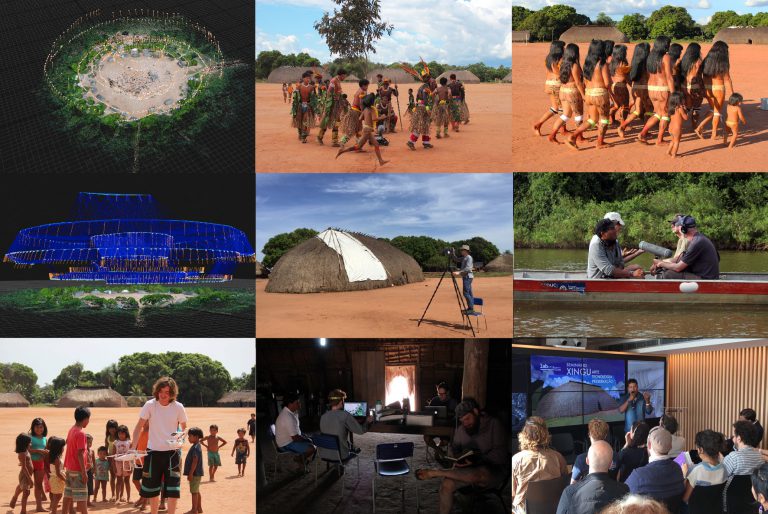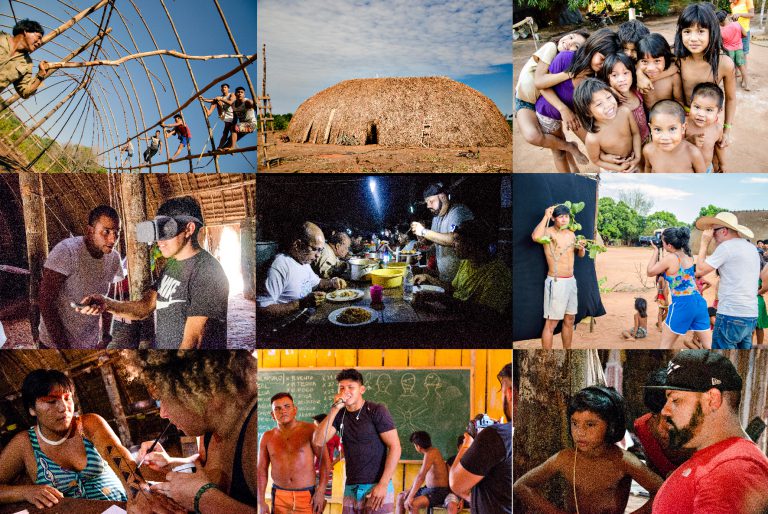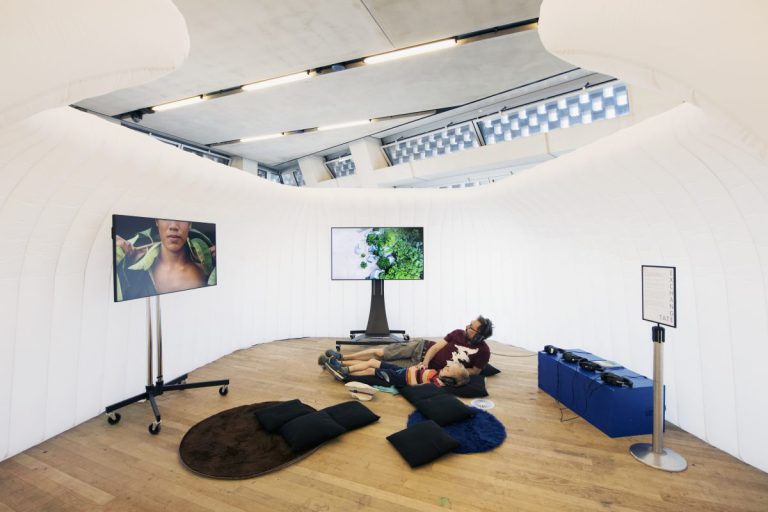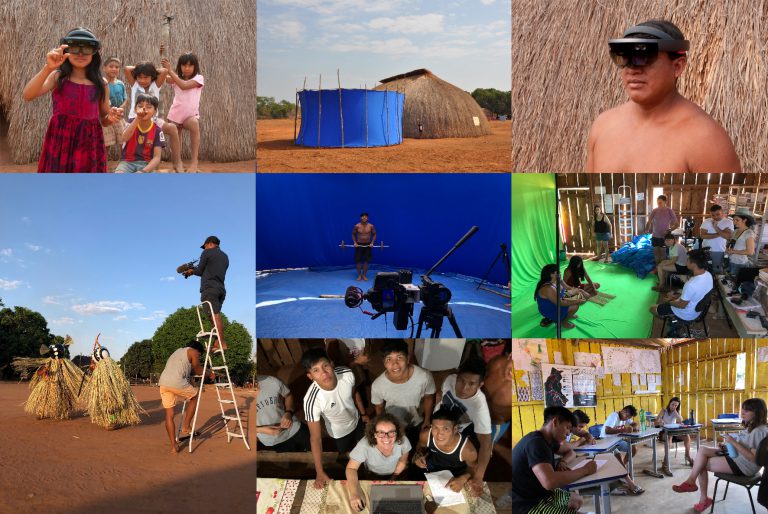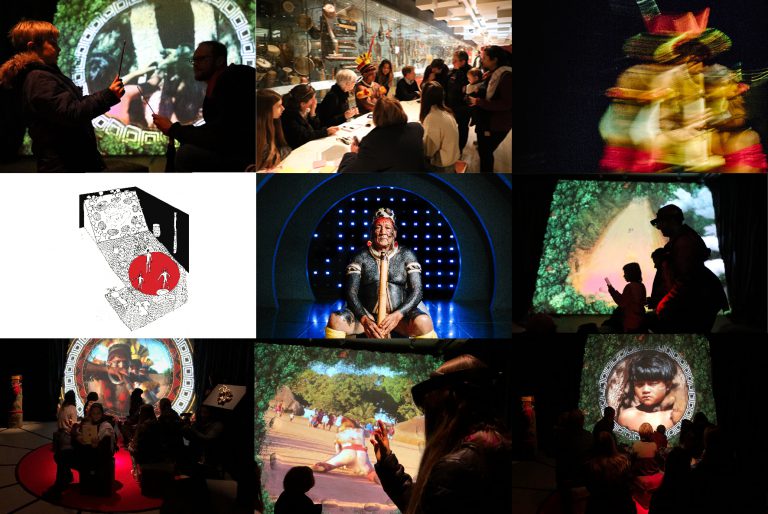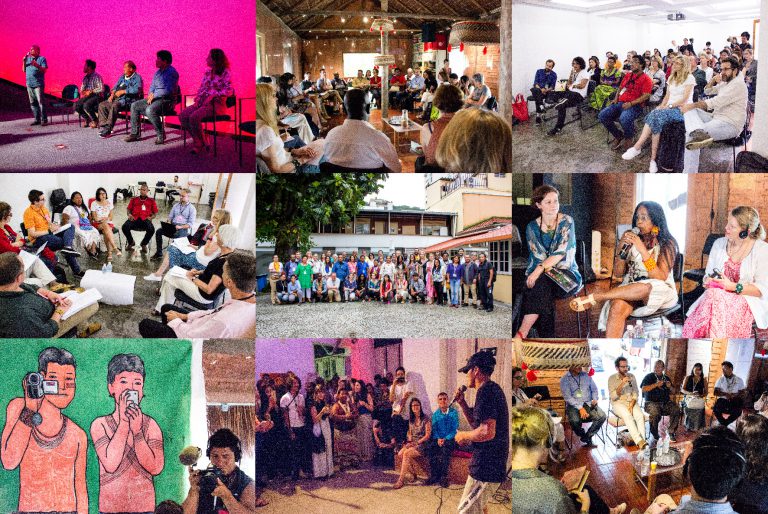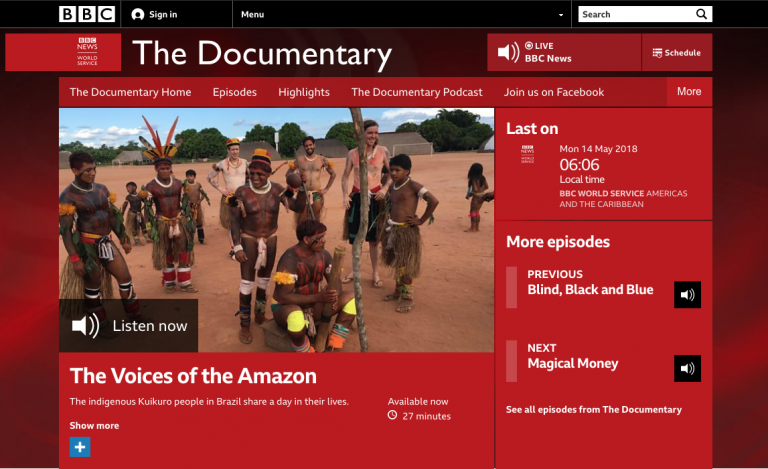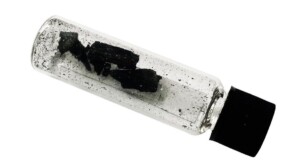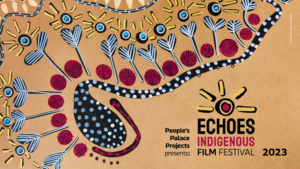Xingu Encounter
Promoting a cultural exchange programme between Indigenous and non-Indigenous artists through residencies in the Xingu Indigenous Territory in Brazil and the UK.
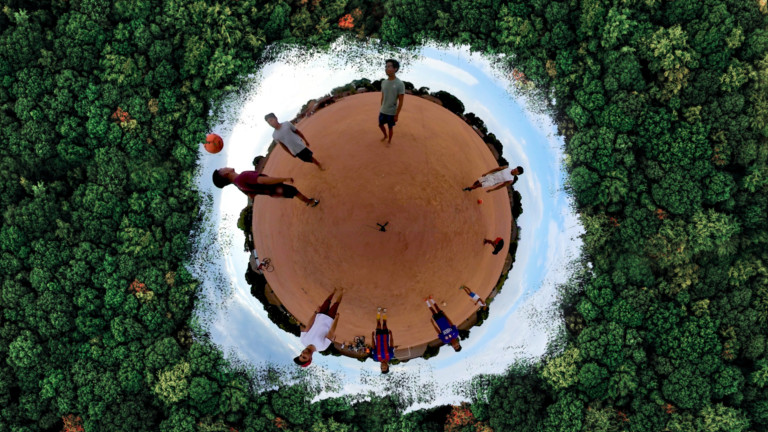
Project Overview
This ongoing collaboration, which started with filmmaker Takuma Kuikuro in 2014, has produced a series of artworks and initiatives documenting, celebrating and advocating for the culture and communities of the Xingu Indigenous Territory.
Museums and galleries have historically been heavily implicated in colonising Indigenous cultures and destroying the vital links between people, cultures and land. People’s Palace Projects believes these same institutions have a crucial role to play in raising international awareness about Indigenous peoples as essential protagonists in the fight against climate change, and in resisting the destruction of their traditional ways of living.
Global recognition and support for Indigenous communities are urgently needed. The Bolsonaro administration has not only failed to protect these communities and landscapes, but has actively introduced legislation that has accelerated unprecedented environmental damage, killings and persecution of Indigenous peoples.
In response to the Covid-19 pandemic, our partnership with the Kuikuro has become about preserving life. By helping to provide infrastructure, food and vital medical support, PPP has supported the community’s lockdown, enabling six villages to treat confirmed cases and stop the spread of the virus. So far, no Kuikuro have died of Covid-19.
About the Kuikuro and the Xingu
Takumã Kuikuro
The Kuikuro are a community of around 650 people who live in the upper reaches of the Xingu River in the Amazon basin. The Xingu is a protected Indigenous territory of more than 2.6 million hectares and home to 16 Indigenous peoples, including the Kuikuro. In 1961, the Brazilian government designated this region as a national park in order to protect the lives and culture of its Indigenous villages and to preserve the surrounding environment.
As the largest area of tropical forest in the ‘arc of deforestation’ of the southern Brazilian Amazon, the Xingu is on the frontline of the climate crisis. Over the past decade, droughts, fires and intensive farming on the territory’s borders have led to the destruction of rivers and forests. Today, the total collapse of these ecosystems is no longer a projection but a reality.
For the Kuikuro people who have inhabited these lands for centuries, artists are itseke, powerful spirits of invisible knowledge. Filmmaker Takumã Kuikuro is a member of the Kuikuro people living in the Ipatse village. Since his first experiences with filmmaking in 2002, Takumã has gone on to direct prize-winning films with widespread international recognition. These works document and preserve the stories, songs, dances and rituals that characterise Kuikuro culture, guarding against the possible erasure of his people’s history and knowledge of living in harmony with nature.
History of the PPP AIKAX partnership (2015–19)
London as a Village (2016)
In April 2015, Takumã travelled all the way from the Ipatse village in the Xingu Indigenous Territory to London to take up a challenge from People’s Palace Projects, as part of the project The Art of Cultural Exchange. The challenge was to spend six weeks in London directing a film that would capture his vision of the city as a ‘village’.
Takumã was selected from dozens of applicants through a grant scheme called Culture Connection Brazil, promoted by Brazil’s Ministry of Culture with the support of the British Council and the Transform Programme. He was commissioned to record London from an Indigenous perspective, exploring similarities and differences between his Kuikuro culture and the Londoners he christened ‘the Hyper-Whites’.
The result is the film London as a Village, a captivating and humorous anthropological documentary about western society and the many villages hidden under the skyscrapers of London.
During his residency in London, Takumã Kuikuro proposed the idea of developing an artistic residency in the Kuikuro Indigenous village, aiming to forge new connections between the Kuikuro and the cultural industries, both in Brazil and abroad. Professor Paul Heritage and Takumã decided to facilitate a pilot collaborative research project that foregrounds Kuikuro cultural practices, and the villages in which they are situated, as a site for training and exchange with non-Indigenous artists in order to extend understanding of how cultural interaction, creative innovation and collaborative cultural production can be conceived and measured as essential to the well-being of the Indigenous communities and individuals.
Artistic Residencies in an Indigenous Village (2017-2018)
In OLOGIKO (Karib word for exchange), Takumã Kuikuro documents the exchanges between Indigenous and non-Indigenous artists and researchers that took place at the Ipatse village in the Upper Xingu between 2017 and 2018. The film also showcases the Kuikuro residence in Rio de Janeiro in 2017, as part of the Multiplicidade Festival, and the immersive installations at Tate Modern and the Horniman Museum in London in 2018.
The residency programme facilitated by People’s Palace Projects aimed to uncover the potential for non-contact technologies to increase public understanding of the Xinguan culture, which we hope will act as an advocacy tool for the articulation of their heritage, culture and rights.
Takumã Kuikuro
PPP and AIKAX (Indigenous Association of the Kuikuro People in Xingu) hosted the 1st artistic residency in the Xingu in May 2017. The two-week artistic residency saw Takumã collaborating with British digital technology artist Adam Lowe (director of Factum Foundation) and Jerry Brotton (scholar in cartographic history at Queen Mary, University of London).
The aim of the programme was to build transformative dialogues through digital technologies that enable the Kuikuro people to create 3D maps of their territories and to explore new ways in which the Indigenous peoples can bring the evolving experiences of first millennial life to contemporary debates about Brazilian economic and social development in the third millennium.
Adam Lowe and a group of four artists and technology experts brought cutting-edge technologies (including a 3D Faro laser scanner) to the Kuikuro village to allow Takumã to digitally record some aspects of Kuikuro’s at-risk cultural heritage, such as images, sounds, graphics, artefacts and architecture. The outcomes of the artistic exchange were presented to the public during the seminar Creative Lab in Xingu: Art, Technology and Cultural Preservation hosted by Museu do Amanhã.
Professor Paul Heritage
A second artistic residency took place in the Xingu Indigenous Territory in September 2017. The Kuikuro constructed a traditional oca (an Indigenous house) as a residency centre for artists in the Ipatse village. Built with the same techniques that they have used for over 1000 years, the oca is a place for visiting artists to learn about their cultural practices and to forge new artistic collaborations. Nine artists from four cultural organisations across Rio de Janeiro (Festival Multiplicidade, Observatório de Favelas, Spectaculu and Agência de Redes para Juventude) spent 15 days with the Kuikuro Indigenous people as part of the research, investigating how we can measure the value of cultural exchange with Brazil’s Indigenous cultures today.
The residency also launched AirB2B, a new artistic exchange programme funded by the British Council. Conrad Murray, rapper and founding member of the BAC Beatbox Academy, was selected among 113 applications to join the residency in Xingu.
Professor Paul Heritage
Back in 2014, Paul Heritage accompanied and supported theatre director Simon McBurney on research trips to the Amazon and Xingu regions to meet Brazilian indigenous people as part of the development of the international smash hit performance, ‘The Encounter’. The trips, and a further meeting between Takuma Kuikuro and Simon McBurney in London, were documented in Complicite’s video diaries, interviews and blogs.
Professor Paul Heritage
In October 2017, the collaborative artistic outcomes were displayed at Festival Multiplicidade, Brazil’s leading art and technology festival. Multiplicidade had an entire week dedicated to the cultural exchange with nine Kuikuro artists that travelled to Rio de Janeiro.
The public had the opportunity to engage with various AV installations; Karib language lessons, traditional body painting, singing and dance workshops; screenings of films by Takumã Kuikuro, talks with Indigenous artists, activists and anthropologists, a workshop on digitisation of cultural heritage at risk; and a virtual reality experience developed during the residency in the Xingu.
The artworks of the residencies in the Xingu were presented in London for the first time in May 2018, during the Mapping the Kuikuro Community event as part of the Tate Exchange week titled, ‘Producing Memory: maps, materials, belongings’. Around 2,000 people had the opportunity to enter an inflatable oca and see photographs and listen to ambisonic sound recordings of the community’s daily life and traditions, watch a video fly-through of scan data from around the Ipatse village, and take part in the Xingu Ensemble VR experience.
The programme also included an interactive photogrammetry workshop with Factum Foundation and a special screening of London as a Village, followed by a discussion on Indigenous experiments in cultural exchange.
During the same month, BBC World Service made available the radio programme, The Voices of the Amazon, which traces a day in Takumã Kuikuro’s life in the Ipatse Village, home of the Kuikuro people in the Xingu region, as well as the clip The Jungle Village Hooked on Their Phones. The recordings were facilitated by PPP during the first residency in the Xingu in May 2017.
In 2018, PPP extended its relationship with AIKAX and associate artist Takumã Kuikuro in an exciting new digital project in partnership with Factum Foundation, The Horniman Museum and Gardens, A Casa Gringo Cardia, Playground Entertainment and WeSense.
A third residency took place in Xingu in September 2018, aimed to combine the digital data capture associated with world-leading cultural conservation practice (such as photogrammetry and 3D scanning/printing) with motion-capture, VR/AR tools such as Oculus Rift headsets, and traditional Kuikuro objects and artefacts to prototype an immersive experience for UK museum audiences of the day to day life, environment, myths and storytelling, dance, graphism, decorative painting, crafts and other cultural practices of the Kuikuro village.
In December 2018, the immersive installation Xingu Village was piloted for two days at the Horniman Museum. By combining digital content, augmented reality tools, ambisonic recordings and never-seen archive footage by Takumã Kuikuro, over 200 people had the opportunity to embark on a museum journey to the Ipatse village. The installation, the first of its kind, involved Indigenous people directly in a process that both preserved and disseminated their social and cultural histories. Through the use of non-contact technologies, the project has raised awareness of remote and fragile Indigenous communities, whose way of life is beyond the reach of the general public, without putting them at risk.
Professor Paul Heritage
Covid-19 Emergency (2020–21)
The Covid-19 pandemic has been a major threat to the survival of Brazil’s Indigenous communities. PPP has collaborated with the Kuikuro to provide food and vital medical support to their community in a safe, sustainable and culturally sensitive way. The early, decisive action to support the community’s lockdown and avoid exposure to external contamination prevented the virus from entering the Kuikuro villages for four months and made it possible for the community to establish an appropriate health structure to treat confirmed cases within their own villages.
Collective fundraising efforts with partners from Complicite and Amazon Hopes Collective, raised awareness about the pandemic in the Xingu and significantly extended this provision, providing two additional health workers, seven hospital beds, oxygen cylinders and essential items to support the community. This included over a tonne of food, 8,300 pieces of personal protective equipment (including gloves, masks, and thermometers), 5,000 units of medicine, fishing equipment and fuel. A car allowed the health professionals to provide emergency aid to the six villages and other health posts in the Upper Xingu.
Of the 921 Indigenous people in Brazil that had died due to Covid-19 by 15 January 2021 (APIB, 2021), none are from the Kuikuro.
OCA RED: Living Beyond the End of the World, Venice Biennale (2021)
Created by Brazilian designer Gringo Cardia with filmmaker Takumã Kuikuro, OCA RED was a video installation presented at the Venice Biennale in 2021. The film reveals the constant and evolving transition that the Kuikuro people maintain between their ancestral past and the future for which they are preparing.
As they engage and exchange with what threatens to destroy them, and as forests burn, rivers dry up and the climate shifts, the project offered an invitation from the Kuikuro, asking us to imagine how we might live together beyond the end of the world we have known so far – enabling visitors at the Biennale to connect their own past, present and future to the everyday life of Indigenous villagers from the Brazilian Amazon.
Reimagining Museums for Climate Action, COP26 (2021)
The next installation went to Glasgow for COP26. Natural Future Museums, a 13-minute film by Thiago Jesus and Takumã Kuikuro, was created for the Reimagining Museum for Climate Action exhibition, presented at Glasgow Science Centre.
The show became part of the official ‘green zone’ for COP26, the United Nations Climate Change Conference. The installation was a call for museums and cultural institutions to radically rethink their engagement with Indigenous communities in the Amazon as a critical part of the fight to protect our future from the climate crisis.
Watch the teaser below.
Natural Future Museums also creates an intervention on the ICOM proposed new museum definition, a 99-word alternative statement formulated at its 139th session in Paris 2019.
